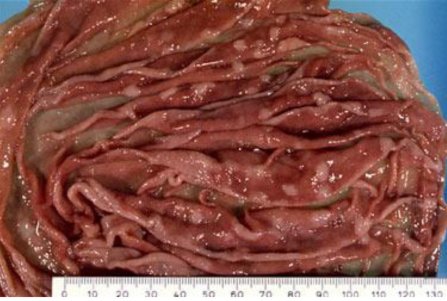These worms are often called ‘Osties’ or ‘Osters’, short for Ostertagia. However, the worm was reclassified in the early 1990s, with the genus name changing from Ostertagia to Teladorsagia. While Ostertagia is a name still commonly used, they are also now called “Tellies”, short for Teladorsagia.
Brown stomach worm occurs in most sheep and goat areas of Australia and is a major parasite in winter rainfall districts. It is relatively rare in Queensland. The brown stomach worm of cattle, Ostertagia ostertagi is known to infect Angora goats, but not sheep.
It is a small red-brown worm, 10 mm in length that is just visible on the lining of the 4th stomach (abomasum). Adult female worms lay 50–100 eggs per day. Adults can become arrested or inhibited inside the sheep or goat for varying periods. They resume activity when environmental conditions become more favourable.
Further ecological information on worms and their control:
The 4th stomach (abomasum).
Death, lethargy and collapse, weight loss, damage and inflammation of the gut resulting in diarrhoea (scouring), and lesions on the wall of the 4th stomach (abomasum) give it a ‘Moroccan’ leather appearance.
Brown stomach worms do not feed on blood, but damage the lining of the stomach as they mature from larvae to adult worms. Sheep or goats with heavy infections rapidly lose condition, develop profuse scours and may die. Entwined masses of worms are found on the lining of the stomach, which is thickened and red and is also covered with whitish nodules (1–2 mm in diameter). The carcass is emaciated.
Animals with fewer worms are unthrifty and daggy.
Mixed infections of brown stomach worm and black scour worm are more lethal than infection with only one of the worms.
Most commonly, brown stomach worm causes production loss in the absence of obvious signs of disease. Affected sheep or goats have reduced appetite and protein loss into the gut resulting in a drop in weight gains by up to 35%. In sheep, wool growth and milk production can each be reduced by 20% before signs become apparent.

The only accurate way to diagnose worm infections before productivity losses have occurred is to conduct a WormTest (worm egg count). The results allow you to make the best choice of drench for the situation.
Visual signs of infection only occur after significant production loss has already occurred. Also, these signs can occur with other parasites and diseases.
There are many options to treat for this worm and your choice will depend on:
Your decision can be assisted by using the Drench Decision Guide, a simple tool that considers some of the points above.
You can also review the Drench pages on this site to find out specific information about drenches, including their drench active, drench group, length of protection, which worms they treat, dose rate, withholding period, export slaughter interval and manufacturer.
Note: only a few drench types are registered for use in goats.
The negative impact of this worm can also be reduced through browsing and grazing management strategies and by using one of the integrated worm control programs that have been developed for different regions across Australia.